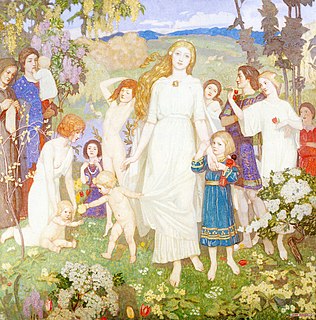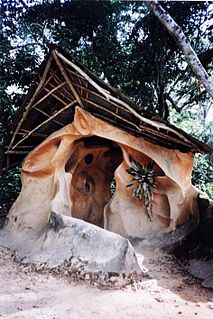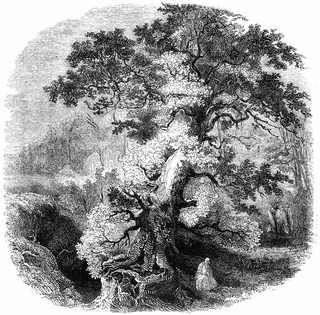Related Research Articles
In Irish mythology, Danu is a mother goddess of the Tuatha Dé Danann. Though primarily seen as an ancestral figure, some Victorian sources also associate her with the land.

Brigid, Brigit or Bríg is a goddess of pre-Christian Ireland. She appears in Irish mythology as a member of the Tuatha Dé Danann, the daughter of the Dagda and wife of Bres, with whom she had a son named Ruadán.

Nemetona, or 'she of the sacred grove', is a Celtic goddess with roots in northeastern Gaul. She is thought to have been the eponymous deity of the Germano-Celtic people known as the Nemetes; evidence of her veneration is found in their former territory along the Middle Rhine as well in the Altbachtal sanctuary in present-day Trier, Germany. She is also attested in Bath, England, where an altar to her was dedicated by a man of the Gallic Treveri people.

In the localised Celtic polytheism practised in Great Britain, Sulis was a deity worshiped at the thermal spring of Bath. She was worshiped by the Romano-British as Sulis Minerva, whose votive objects and inscribed lead tablets suggest that she was conceived of both as a nourishing, life-giving mother goddess and as an effective agent of curses wished by her votaries.

A grove is a small group of trees with minimal or no undergrowth, such as a sequoia grove, or a small orchard planted for the cultivation of fruits or nuts. Other words for groups of trees include woodland, woodlot, thicket, and stand.

Sacred groves or sacred woods are groves of trees and have special religious importance within a particular culture. Sacred groves feature in various cultures throughout the world. They were important features of the mythological landscape and cult practice of Celtic, Estonian, Baltic, Germanic, ancient Greek, Near Eastern, Roman, and Slavic polytheism; they also occur in locations such as India, Japan, West Africa and Ethiopia Examples of sacred groves include the Greco-Roman temenos, various Germanic words for sacred groves, and the Celtic nemeton, which was largely but not exclusively associated with Druidic practice. During the Northern Crusades of the Middle Ages, conquering Christians commonly built churches on the sites of sacred groves. The Lakota and various other North American tribes regard particular forests or other natural landmarks as sacred places. Singular trees which a community deems to hold religious significance are known as sacred trees.

A nemeton was a sacred space of ancient Celtic religion. Nemeta appear to have been primarily situated in natural areas, and, as they often utilized trees, they are often interpreted as sacred groves. However, other evidence suggests that the word implied a wider variety of ritual spaces, such as shrines and temples. Evidence for nemeta consists chiefly of inscriptions and toponymy or place-names, which occur all across the Celtic world. Toponyms related to the word nemeton occur as far west as Galicia in the Iberian peninsula, as far north as Scotland, and as far east as central Turkey. The word is related to the name of the Nemetes tribe living by the Rhine between the Palatinate and Lake Constance in what is now Germany, and their goddess Nemetona.
The Nemetati were an ancient Celtic tribe of Gallaecia, living in the north of modern Portugal between the Cávado and Ave Rivers, in the province of Minho, north of the Douro.They lived near the valley of the Ave River and may have some link with inscriptions to the war god Cosus Nemedecus. The Citânia de Sanfins could be their main hill fort. Their ethnic name comes from the Celtic nemeton, a place belonging to the sacred site/grove, or more likely, place belonging to Nemetos.

Ancient Celtic religion, commonly known as Celtic paganism, was the religion of the ancient Celtic peoples of Europe. Because the ancient Celts did not have writing, evidence about their religion is gleaned from archaeology, Greco-Roman accounts, and literature from the early Christian period. Celtic paganism was one of a larger group of Iron Age polytheistic religions of Europe. It varied by region and over time, but underlying this were "broad structural similarities" and "a basic religious homogeneity" among the Celtic peoples.

"Matty Groves", also known as "Little Musgrave and Lady Barnard" or "Little Musgrave", is a ballad probably originating in Northern England that describes an adulterous tryst between a young man and a noblewoman that is ended when the woman's husband discovers and kills them. It is listed as Child ballad number 81 and number 52 in the Roud Folk Song Index This song exists in many textual variants and has several variant names. The song dates to at least 1613, and under the title Little Musgrave and Lady Barnard is one of the Child ballads collected by 19th-century American scholar Francis James Child.

Osun-Osogbo is a sacred grove along the banks of the Osun river just outside the city of Osogbo, Osun State of Nigeria.

Trees are significant in many of the world's mythologies, and have been given deep and sacred meanings throughout the ages. Human beings, observing the growth and death of trees, and the annual death and revival of their foliage, have often seen them as powerful symbols of growth, death and rebirth. Evergreen trees, which largely stay green throughout these cycles, are sometimes considered symbols of the eternal, immortality or fertility. The image of the Tree of life or world tree occurs in many mythologies.

A sacred garden is a religiously-influenced garden, often found on temple grounds.
Celliwig, Kelliwic or Gelliwic is perhaps the earliest named location for the court of King Arthur. It may be translated as 'forest grove'.

Sacred groves of India are forest fragments of varying sizes, which are communally protected, and which usually have a significant religious connotation for the protecting community. Hunting and logging are usually strictly prohibited within these patches. Other forms of forest usage like honey collection and deadwood collection are sometimes allowed on a sustainable basis. NGOs work with local villagers to protect such groves. Traditionally, and in some cases even today, members of the community take turns to protect the grove. The introduction of the protected area category community reserves under the Wild Life (Protection) Amendment Act, 2002 has introduced legislation for providing government protection to community held lands, which could include sacred groves.

In ancient Roman religion and myth, Mars was the god of war and also an agricultural guardian, a combination characteristic of early Rome. He was the son of Jupiter and Juno, and was pre-eminent among the Roman army's military gods. Most of his festivals were held in March, the month named for him, and in October, which began the season for military campaigning and ended the season for farming.

Many types of trees found in the Celtic nations are considered to be sacred, whether as symbols, or due to medicinal properties, or because they are seen as the abode of particular nature spirits. Historically and in folklore, the respect given to trees varies in different parts of the Celtic world. On the Isle of Man, the phrase 'fairy tree' often refers to the elder tree. The medieval Welsh poem Cad Goddeu is believed to contain Celtic tree lore, possibly relating to the crann ogham, the branch of the ogham alphabet where tree names are used as mnemonic devices.
According to classical sources, the ancient Celts were animists. They honoured the forces of nature, saw the world as inhabited by many spirits, and saw the Divine manifesting in aspects of the natural world.

Trees hold a particular role in Germanic paganism and Germanic mythology, both as individuals and in groups. The central role of trees in Germanic religion is noted in the earliest written reports about the Germanic peoples, with the Roman historian Tacitus stating that Germanic cult practices took place exclusively in groves rather than temples. Scholars consider that reverence for and rites performed at individual trees are derived from the mythological role of the world tree, Yggdrasil; onomastic and some historical evidence also connects individual deities to both groves and individual trees. After Christianization, trees continue to play a significant role in the folk beliefs of the Germanic peoples.
References
- ↑ Miranda J. Green. Dictionary of Celtic Myth and Legend. Thames and Hudson Ltd, London, 1997.


